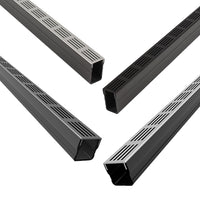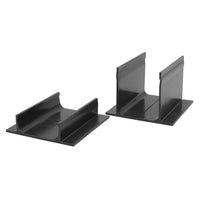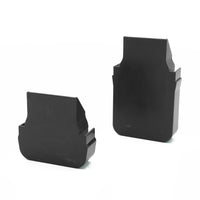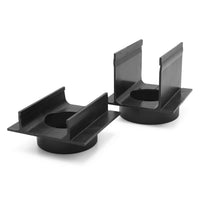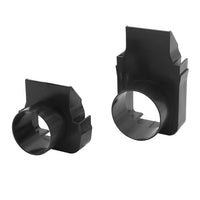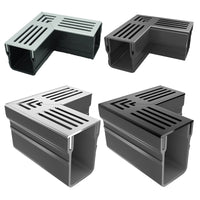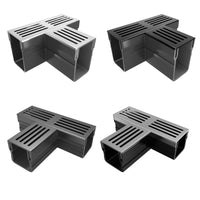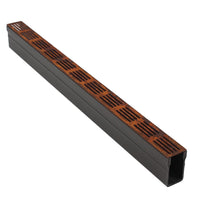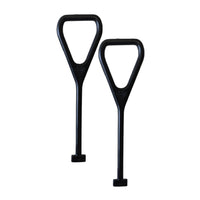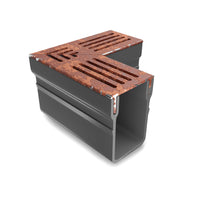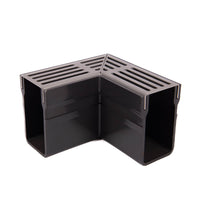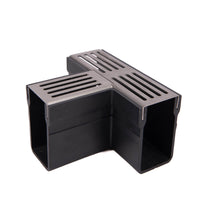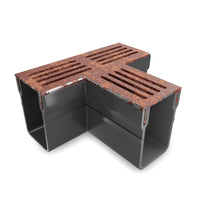Light Duty Linear Drainage Channels For Indoors & Outdoors
Threshold drainage channels (often called linear drainage channels or trench drainage channels) are a type of drainage system designed to limit the amount of water that collects on impermeable surfaces, especially those around building entrances. When strategically placed, they manage surface runoff, redirecting excess water and transferring it to water bodies elsewhere.
Although they can be used in both commercial and residential spaces, internal and external, threshold drain channels are the most light-duty drainage solution, making them ideal for specific environments, like where unwanted water regularly pools around a building’s entranceway or gets inside. This provides attractive architectural detail while strategically redirecting excess water runoff.
When intelligently placed, threshold drain channels can manage the direction of water flow, transferring water to larger bodies or to local drainage systems to then be carried away, offering a durable and long-term preventative measure against water damage. This contributes to maintaining a safe living (or working) environment for individuals within the building, as well as those who regularly use its entrance (like postmen or delivery workers).

Load Classification
The most important factor to consider when installing a channel drain is how much weight it will support. Channel drainage is categorised into classes which conform to BS EN 1433:2002 standards and specify applications of use; if the project involves a residential driveway, then a lighter-duty trench drainage channel will probably be enough.
Standard Weight Load Classes for Linear Drainage Channels (according to BS EN 1433):
| Load Class | Test Force in kN | Max. Weight Load (Tonnes) | Use Case | Industry |
| A15 | 15 | 1.5 | Most light duty, pedestrian areas like gardens, patios and driveways. Domestic use | Domestic / Light Duty |
| B125 | 125 | 12.5 | Domestic driveway thresholds for family cars, vans and 4x4s | Domestic / Light Duty |
| C250 | 250 | 25 | Lightly trafficked roads and small private car parks | Commercial |
| D400 | 400 | 40 | Main roads, highways and high traffic areas such as public car parks | Commercial |
| E600 | 600 | 60 | Industrial estates, loading bays and cargo handling yards | Heavy Duty |
| F900 | 900 | 90 | Docks and airports, extreme heavy duty applications | Heavy Duty |
Consider all future applications carefully when deciding which class of drainage channel solution is necessary for your space, however. For example, a B125 channel drain may be suitable for a regular driveway, but if delivery or waste disposal lorries will be passing over the channel (even occasionally), then a more heavy-duty drain will have to be considered to prevent future breakages.
Applications
Threshold drains (channels with a max class of B125) are the lightest-duty form of drainage channel and should be used exclusively in pedestrian zones that, depending on their load class, never see more than 12.5 tonnes of weight at any one time. Although they’re perfect for patios, pathways, walkways, door thresholds, and block paving areas without vehicular traffic, they can also be used internally, around pools, conservatories or even greenhouses.
Recommended Applications
- Pedestrian access to residential and commercial buildings
- Patios and Paths
- Threshold door drainage, e.g. garage doors and business entryways
- Flush threshold drains for doors (often underhanging a doorway).
Non Recommended Applications
- Car Parking areas
- Across roads
- Public spaces with vehicle access
Key Features and Benefits of Threshold Drainage Channels (Classes A15 & B125)

Features
- Easy and cost-effective installation
- Range of specialised pedestrian gratings like Heelguard™ which reduce damage to high heeled footwear
- Aesthetic improvements thanks to our range of colours and styles
- Easily removable gratings for inner channel access

Benefits
- Suitable for use in Building Regulations Part M compliant installations in England and Wales and Building Standards Section 4 compliant installations in Scotland
- Stop water pooling in key areas (like a building's entrance), protecting walls and foundations
- Reduces surface runoff in urban environments, reducing the risk of local flooding. Positive environmental impact
Choosing the Best Kind Of Channel Drain For My Needs

Location
Considering the slope, gradient, and overall landscape of the particular site where the threshold drain will be installed. Take note of local water flow patterns to understand the natural flow of water in the area and ensure that the threshold drain is positioned to intercept and redirect water away from the building.
Consider the environmental impact of the drainage system. Assess how the drain contributes to water conservation and flood prevention in the surrounding area, how it will affect local habitats and whether water runoff will contain any chemicals.

Installation
For the ideal installation depth, consider the quantity of water you’re likely to see in that area and the characteristics of the surrounding surface to prevent the accumulation of pooled water. Keep the top of the channel around 3-5mm below the surrounding paving to prevent water from flowing back during periods of heavy rainfall.
Evaluate the drainage capacity of the threshold drain to ensure it can handle the expected volume of collected water during heavy rain or other weather conditions. If connecting your channel to existing drainage systems, ensure a secure connection is made and choose a suitable outlet size (e.g. 50mm or 80mm) for effective water disposal. For reliable installation, get into contact with us, and we will send a professional who will ensure precise placement, alignment, and connection to the drainage system.

Material & Maintenance
Consider the durability of the materials used in the threshold drain, especially since it will be exposed to weather elements. Ensure the materials can withstand long-term use and consider the effects of any chemical impurities that this excess water may be carrying with it.
Plan for easy access and maintenance of the threshold drain. Decide whether you want a one piece drainage channel, or one with removable gratings. Ensure that it can be easily cleaned and inspected to prevent clogging and ensure proper functionality.

Regulations
Before installation, it is essential to assess the compliance of the threshold drain with building regulations in your region, (Part M of the Building Regulations for England and Wales).
Confirm that the threshold drain holds the correct certifications (including UKCA and CE marking in the UK), and adheres to load class industry standards (such as BS EN 1433:2002 in the UK) suitable for the anticipated load - especially if it will be exposed to heavy traffic or vehicular loads.

Finish & Aesthetics
Choose the appropriate grating style (e.g., removable heel guard) and material based on the intended use and the level of pedestrian traffic. Make sure to choose a finish that complements the overall design and aesthetics of the building or outdoor space. Choose from our range of aluminium, steel and stainless steel.
Want To Install a Threshold Drainage Strip?
At Start Safety, we have a large range of threshold drains for sale. We also stock the complete range of tools and materials needed to create an effective threshold drainage channel!
Whether you’re looking for tools, the products themselves, or help with installation, get into contact with our team today on +44 (0)1905 794875, or use the instant chat below, and we will assist you to the best of our capabilities!

